
![]()
This
is a north part of Thailand, bordering Thailand to Myanmar, China and Laos.
There are 15 provinces in this region e.g. Pitsanulok, Pijit, Kumpaengpet, Tak,
Sukhothai, Prae, Nan, Uttaradit, Petchaboon, Lumpang, Lumpoon, Chaing Mai, Chaing
Rai, Payao and Mae Hongson.
Although
all 15 provinces are practically categorized the northern provinces, they are
subdivided in to several groups, possessing their own unique characteristic
and cultures. For example, a group of Pitsanulok, Pijit, Sukhothai and Kumpaengpet
is called the upper central region because their cultures are similar to the
central region of Thailand. Mae Hongson has cultures that are rather the mixture
of Thai Yai and Burmese. Petcahboon's cultures are more alike those of the northeast's.
A group of provinces that really and uniquely posses real northern cultures, consisting Lumpang, Lumpoon, Chaing Mai, Chiang Rai and Payao, is called Khon Muang, Yuan, or Thai Yuan which refers Yonok. Phrae and Nan also have their own characteristics.
In the past, Thai people lived in scattered groups in the region of Indo-Chinese peninsula. Thai people living in the north set up their houses in the abundant flat area between the hillsides. As seen by historical records, the northern Thai had settled down and had been ruled by kings in the region for very along time. The most obvious ancient community, based on the evidences, is the king dom of Nan Jao. The kingdom situated in Hunan region of China, defeated and destroyed by Chinese forces in the year 1796 of the Buddhist era. Then, the kingdom of Chiang Saen started to settle their civilization since the 16th century of the Buddhist era. In 18th century of the Buddhist era, the biggest Thai group was divided in to 3 kingdoms; Chiang Saen in the north, Sukhothai in the central and the south, and Lan Chang on the east coast of Mekhon river that is, at present, Laos and the northeast of Thailand.
King Mung Rai, the establisher of the Lan Na kingdom
King Mung Rai was a son of king Lam Meng and Queen Ming Jom Muang (Tep Khum Kai or Kum Ka Yai), a daughter of king Rung Kaen of the city of Chiang Rung. King Mung Rai ruled a city of Ngoen Yang in year 1804, the Buddhist era, and had spread out his territory, took over Lumpoon in 1835. He built Wiang Koom Kam in 1837, the Buddhist era, but the area was flooded, so he built the city of Chaing mai in 1839, the Buddhist era. Chiang Mai later became the center of the kingdom of Lan Na.
The kingdom of Lan Na had developed in 3 periods.
- Foundation period (1839-1898 B.E.);King Mung Rai gathered towns in Chiang Rai region and spread his power to Chiang Mai and Lumpoon region. All important cities; which are Chiang Rai, Chiang Saen, Chiang Mai, Lumpoon, Lumpang, and Payao; were completely under his control. He sent a crown prince to rule Chiang Tung and Nai. There were 5 king consecutively ruled the king dom, King Paya Payu was the last one.ู
- Period of Lan Na's great prosperity (1898-2068 B.E.);Started from the reign of king Kue Na until king Kaew, lasting for 170 years. The most prosperous time was in the reign of king Tilokaraj (1984-2030 B.E.). This period was regarded as the time of greatest prosperity of the kingdom of Lan Na. The kingdom expanded to Prae and Nan, and widened its influence over Chan State and Luang Pra Bang. Buddhism also highly achieved its remarkable prosperity. So there was an amendment for Tripitaka (Buddha's teachings) for the 8th time since Buddha's departure.
- 3. Period of the deterioration and disintegration of the Lan Na kingdom (2068-2101 B.E.); Started from the reign of king Ket Chettaraj until the time that Burmese's take over, which lasted 33 years. In 2101 B.E., in the reign of king Mae Ku, Burengnong (Burma's king) managed to take over Chiang Mai. Since then, Burmese had ruled Lan Na for more than 200 years. In 2317 B.E., in the reign of King of Thonburi, Chiang Mai became Thailand's colony. Later, cities in the north has become northern provincials of Thailand, which have been progressively developed.
Category of Lan Na kings
|
1.
1. King Mung Rai
|
reigned
|
1804-1854 B.E. |
|
2.
King Chai Songkram
|
reigned
|
1854-1868
B.E.
|
|
3.
King Saen Poo
|
reigned
|
1868-1877
B.E.
|
|
4.
King Khum Fu
|
reigned
|
1877-1879
B.E.
|
|
5.
King Pa Yu
|
reigned
|
1879-1898
B.E.
|
|
6.
King Kue Na
|
reigned
|
1998-1928
B.E.
|
|
7.
King Saen Muang Ma
|
reigned
|
1928-1944
B.E.
|
|
8.
King Sam Fung Kaen
|
reigned
|
1945-1984
B.E.
|
|
9.
King Tilokaraj
|
reigned
|
1984-2030
B.E.
|
|
10.
King Yod Chiang Rai
|
reigned
|
2030-2038
B.E.
|
|
11.
King Kaew
|
reigned
|
2038-2068
B.E.
|
After King Kaew, Lan Na kingdom was rule by Burma
Category of King of Chiang Mai
|
1.
King Kawila
|
reigned
|
2325-2356
B.E.
|
|
2.
King Thama Lunka
|
reigned
|
2358-2364
B.E.
|
|
3.
King Khum Fun
|
reigned
|
2366-2368 B.E. |
|
4.
King Buddhawong
|
reigned
|
2369-2389
B.E.
|
|
5.
King Mahot Pratet
|
reigned
|
2390-2397
B.E.
|
|
6.
King Kawiloros Suriyawong์
|
reigned
|
2399-2413
B.E.
|
|
7.
King Indha Wichayanont
|
reigned
|
2416-2439
B.E.
|
|
8.
King Indha Waroros Suriyawong
|
reigned
|
2444-2452
B.E.
|
|
9.
HRH General Kaew Nawarat
|
reigned
|
2454-2482
B.E.
|
Lan Na's administration was divided into main categories as below;
- The capital region, which were Chiang Mai and Lum Poon. The absolute power belonged to the king only. This is a center of all governmental power.
- Cities ruled by authorized high-ranking government's representative or members of royal family. The latter certainly had close connection to the capital power but, however, the ruler of each city had absolute right to rule their people and territory.
- Colonized cities, which were distant from the capital. The rulers of these cities agreed to submit their tributes to the bigger cities because they realized that they were weaker.
The administration was arranged by rankings. Cities with higher rank means that they possessed more land. The unit of land was counted as "Panna". For example, Chiang Rai possessed 32 Pannas, Payao with 36 Pannas, Fang with 5 Panna. Each Panna had a ruler ranked as Muen Na, Lamna, Panna Lung, and Saen Na. The smaller area of administration was called Pakna. A Pakna had 500 families (approximately 500 houses). There were 2 ways to control Panna. First, control for erging them to submit tributes to ruling city. Second, control for recruiting labour that could be done both during wars and peacetime. Therefore, to rule meant to provide authorized personnel to take control the area.
People of Lan Na mostly lived with agricultural lifestyle. Since most of the area are mountainous and only 1/4 of the area are flat area. Farmers grew rice by water reservation method. Kao Rai (Rice grown in hilly area) was grown in higher lands. Flat areas between mountains (So called "Aeng"); such as Aeng Chiang Mai, Lumpoon and Aeng Chiang Rai; are suitable for growing rice and other plants. But those of Lum Pang, Prae, and Nan produced less rice. The economy system was only a production for domestic consumption. They used cows to carry their goods to other cities. The goods were wild products, salts, clothes, and jewelry. Local market was "Kart Mua", which meant that anyone could bring anything to sell at this place.
The northerners preferred to build their houses close to each other to assemble a group or a village, mostly located along the riverside or at the abundant areas. The northern houses are mostly wooden, lifted above ground. The space under the house was used to keep agricultural equipment or for relaxation. Roof are covered by tiles or pieces of teakwood, which are bigger and last longer than tiles. High quality teakwood can last longer than 50 years.
Next to the house is a rice silo, big or small depending on the owner's wealth. Besides this, there would be poultry, cattles, horses, orchards, and vegetable planting area.
People of Lan Na were like general Thai people. Only they descend from Tai Yuan or Yonok ancestry. Lan Na people call themselves "Khon Muang", which distinct from other group of Thais, that is, they have rather paler skin, compact body, mostly thin, have their own spoken language called "Khum Muang". The writing pattren of Northern Thai language is called "Lan Na" alphabets, recording Buddhism stories, literatures, also laws and local knowledge. Lan Na alphabets were developed from ancient Mon (Peguan) alphabets, which age as equally as King khun Ram Khum Haeng, or evenMostly farmers, either paddy farming or orchard gardening. Only on a very low land that they would do spread paddy farming for rice. The northern normally consume sticky rice, which is very high quality, that is, clean, soft and scented. The famous one is Sun Pa Tong breed. Others popular plants are onions, garlic beans and tobacco. Fruit orchards, such as longan and Lichee, are also popular. Besides domestic consumption, these products are also main exports.
Another occupation of the northern is making "Miang"(tea leaves prepared for chewing). The northern like chewing Miang. Young tea leaves are leavened until they taste slightly sour and acidulous. Appropriately long leavened tea leaves are consumed by mixing with salt or other snacks as desired.
Besides chewing Miang, the northern also like smoking. Tobacco wrapped by banana leaves, with a finger size, 8 inches long. Northerners call this kind of cigarette "Ki Yo" or "Bu Ri Ki Yo". The reason that northern like smoking may be the cold weather and smoking keep them warm.
Beside agricultural occupations, handicraft and family business are also widely practical. Women do cloth weaving after their paddy field work. Sculptures, lacquer wares, silver ware, and iron ware are also broadly produced.
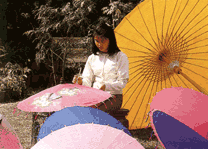 |
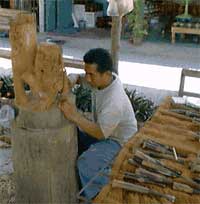 |
The local northern costumes for men and women are different. Men wear trouser with 3/4 length of legs, so called "Tiew" or "Tiew Sa Dor", made of cotton and dyed in blue or black. Shirt, called "Sua Mor Hom", is made from cotton, short sleeves, 5 black or blue chest bottoms. They wear this dress when working.
For women, they wear big, full-length legs, piece of cloth called "Siin". A siin is a beautifully designed piece of cloth. Their shirts are equally beautiful. The northern women are concerned about their dress very important. They always dress beautifully. As said in a northern proverb;
When having a bad time to feed yourself, no one notices.When being incapable to dress beautifully, it's disparaging.
The northerners are kind, polite, and modest. Especially, their hospitality is well regarded. They like greetings and welcoming people to their home. This also applies to northern women and, unintentionally, may cause misunderstandings to visitors.
Like most of Thais, the northerners' old believes are based on the respect to spirits and ghost. Each family worships their own regarded spirits. Also, each village worships spirits of the village, for example, the spirits of ancestors, lands and trees. When Buddhism spread to the north, the northerner had become strict Buddhists. Almost every village has a local temple. Parents traditionally wish their sons to be Buddhist monk. In Mae Hong Son, the ceremony of becoming monks is called "Buad Luk Kaew". When the boys enter to his 9 years old, their parents regard that they are so pure and suitable to become monks. The ceremony is seriously taken. Boys of the same age are normally appointed to become monks at the same ceremony. Boys are luxuriously dressed as if they are kings. When parade begins, boys are sitting on horses, covered by big umbrellas. The parade is also beautifully decorated. After boys have become novices, they have to study Buddhism in the temple until they are 19 years old. Then they would leave monkshood and would be called "Noi" before their names as, for example, Noi Chaiya. For those who continue being monks for a few more years, after they leave monkshood, they would be called "Nan" as, for example, Nan Ho or Nan Inta.
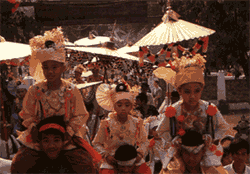 |
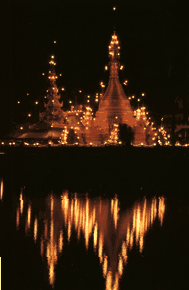 |
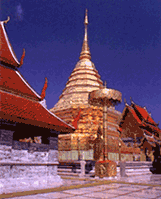 |
|
"Buad
Luk Kaew" ,
Mae Hong Son Province |
Wat
Chong Klang,
Mae Hong Son Province |
Doi
su Teap,
Chiang Mai Province |
|
Pictures from Thailand
Executive Diary 1997
|
||
The
northerners live with nature, so they are so kind and calm. They love beauties
of natures, arts and music. They are well known in artistic skills such as sculptures,
carvings, silverware and lacquerware. All of these products' beauties reflect
the great skills of the northerner.
In
the area of music and plays, there is a band that is called "Wong Salor
Sor Sueng". A classic northern dance are "Fon Leb"(Nail dance)
and "Fon tien"(Candle dance). Local plays are "Joi", "Sor"(like
"Mor Lum" of the northeast), which is the acting like a play of men
wooing women. This local play can still be seen at local ceremonies, though
there is less than before.
The
northerners regularly consume sticky rice and meat as their meals. Only small
amount of seafood consumed. Perhaps, because they believe that seafood can cause
illness. Vegetables consumed are locally available. The ways of cooking are
normal i.e. both dry and watery, for example, Lab(meat salad), Lue(blood salad),
Sai Ua(sausage), steamed pork, Ho curry, and vegetable curry.
There
is one kind of food that northern must have it in their menu. That is "Tua
Nao" (leavened and baked beans), which is made of Soya beans, leavened
then spread as a thin round sheet. Then it is left in the sunlight. Dried Tua
Nao are kept, as main ingredient, in kitchen and used to mix with other foods
when desired.
The use Soya beans, as ingredients for foods are absolutely genius of the northerners because Soya beans are main source for nutrition and energy.
Another unforgettable food is Lue, an uncooked and savory dish.
Lue
is a kind of meat salad, northern style, mixed with blood. Lue can be cooked
from pork, cow meat and baffalo meat, which is finely chopped, then mixed with
sliced animal's organs. It tastes sour, salty, and strongly spicy. Popularly
consumed with liqueur. Salad dish is served as a side dish for Lue. In the northeast,
there is a similar kind of food, called blood salad, but this one is more watery,
not quite thick as Lue of the north.
The total of population in the north is at least 15 million. The northerners have rather pale skin. They mostly do agricultural works and are Buddhists, love to make merits and seriously preserve their unique traditions. They naturally kind and have good hospitality. Like staying with natures and peaceful environment. Generally medium rich, but there are still a lot of poor people. In the past, there were a lot of northern women had to go to prostitution. That is because of they were poor. Thai government continuously tried to solve this problem by providing more education, development for community, and providing more jobs. Finally, the problem progressively reduced. Above all, all Thais are, no matter where and which region they are, still Thai who have same origin. They always have love and good relation for each other, by blood and the origin of cultures.
![]()
![]()
![]()
Translator
: Aketawan Manowongsa